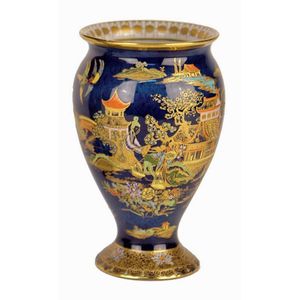Green Babylon Vase with Gilded Detail and Small Chip
You must be a subscriber, and be logged in to view price and dealer details.
Subscribe Now to view actual auction price for this item
When you subscribe, you have the option of setting the currency in which to display prices to $Au, $US, $NZ or Stg.
- Lustre Ware - Lustre decoration on ceramics is created by painting a thin deposit of metal oxide such as gold, silver or copper onto the surface, and then firing the item again, so that metal oxide forms a thin film on the surface. The finished effect is a shiny metallic surface. The technique was used in the 19th century by potteries such as Crown Devon, Grimwades, Maling, and Royal Doulton. However the best known use was by Wedgwood for its Fairyland lustre.
- Gilding - Gilding is a method of ornamentation whereby a thin sheet of gold metal is applied to items made of wood, leather, ceramics, glass and silver for decorative purposes.
For furniture including mirrors, the sheet of gold is usually applied over a coating of gesso. Gesso is a mixture of plaster of Paris and gypsum mixed with water and then applied to the carved wooden frames of mirrors and picture frames as a base for applying the gold leaf. After numerous coats of gesso have been applied, allowed to dry and then sanded a coat of "bole", a usually red coloured mixture of clay and glue is brushed on and allowed to dry, after which the gold leaf is applied. Over time parts of the gilding will rub off so the base colour can be seen. In water gilding, this was generally a blue colour, while in oil gilding, the under layer was often yellow. In Victorian times, gilders frequently used red as a pigment beneath the gold leaf.
Metal was often gilded by a process known as fire gilding. Gold mixed with mercury was applied and heated, causing the mercury to evaporate, the long-term effect of which was to kill or disable the craftsman or woman from mercury poisoning. The pursuit of beauty has claimed many victims, not the least of which were the artists who made those pieces so highly sought after today.
This item has been included into following indexes:
Visually similar items

A Carlton Ware vase, of inverted baluster form on a round spreading foot, decorated in a chinoiserie pattern in colourful gilt and enamel on a cobalt blue ground. Height 15 cm

A large Doulton Lambeth stoneware vase by Hannah Barlow, circa 1890, incised artist monogram and impressed marks, 42 cm high

A French 'Verrerie D'Art Degue' glass vase, acid etched trees and flowers in green and purple on a deep cream ground, signed 'Degue' (David Gueon) to the base, early 1900s, base broken and repaired. 18 cm x 32 cm

A Carlton Ware 'Forest Tree' vase, circa 1928, pattern 3244, shape 406. the waisted baluster vase depicting stylised birch trees with moody teal and black foliage contrasting with white trunks, with gilt enriched pendant foliage and streaking clouds upon a
